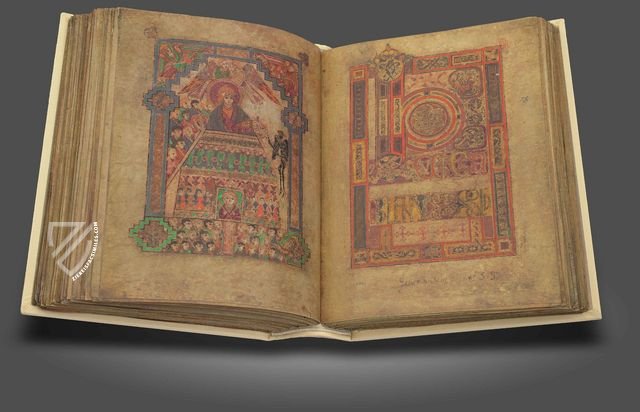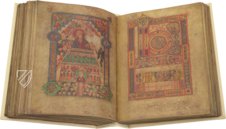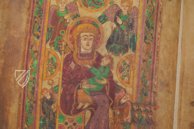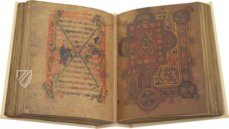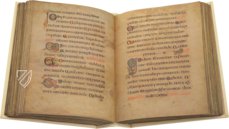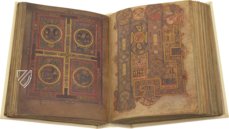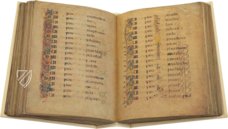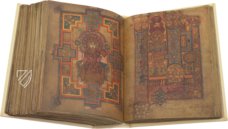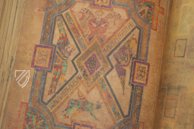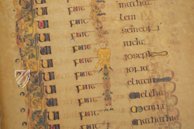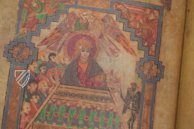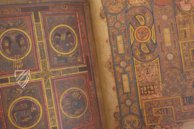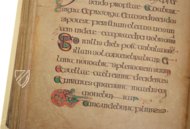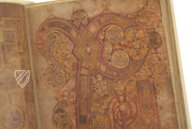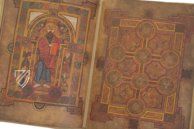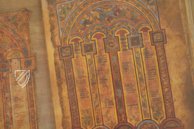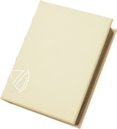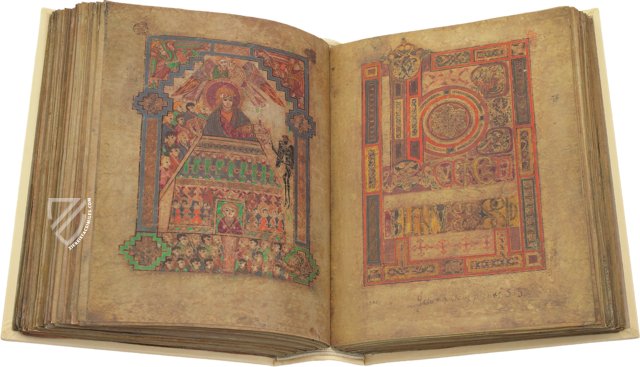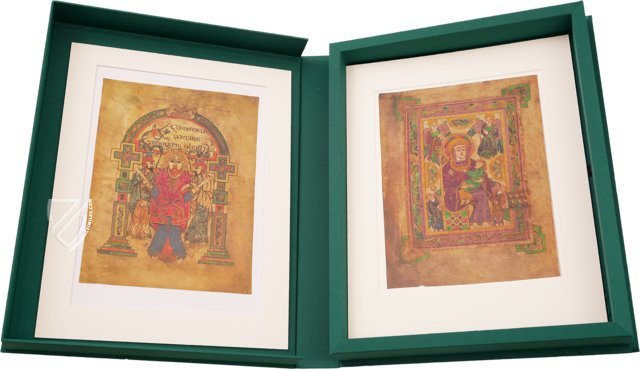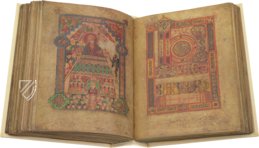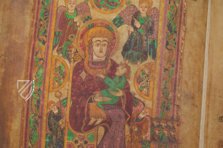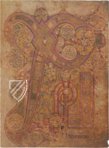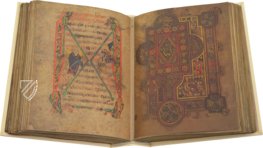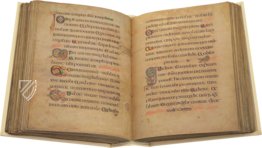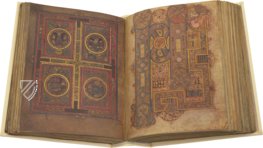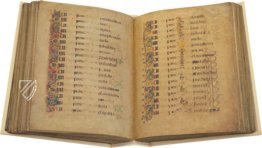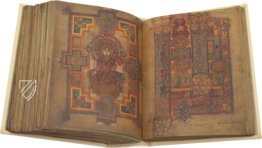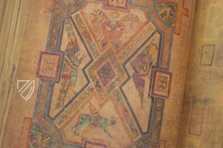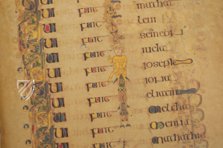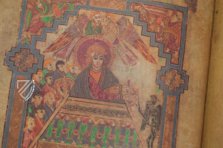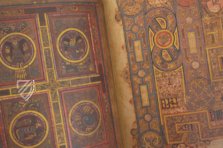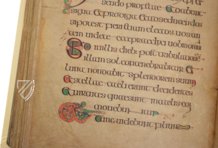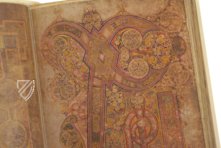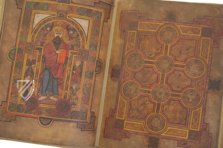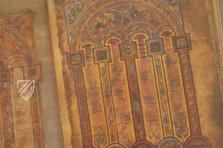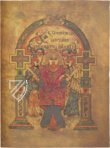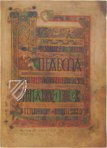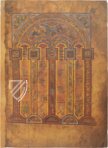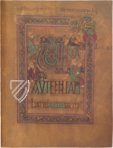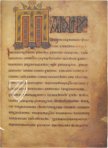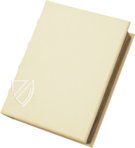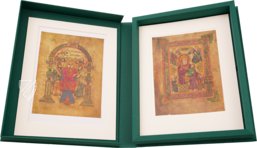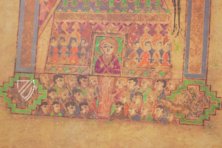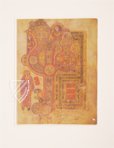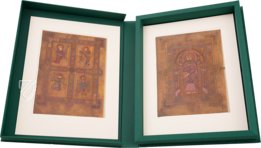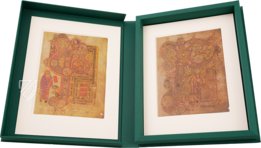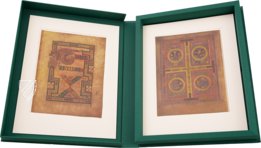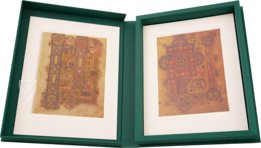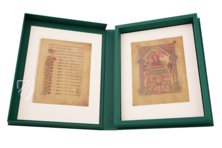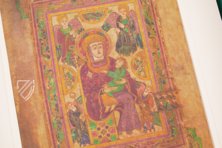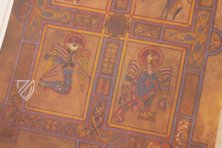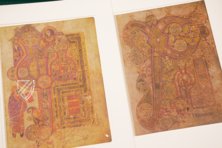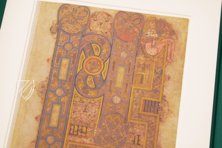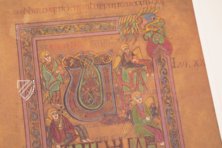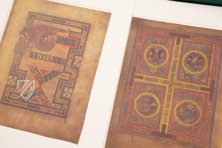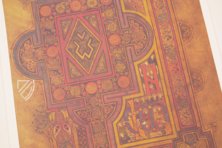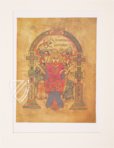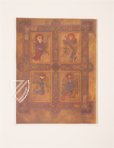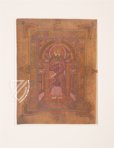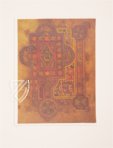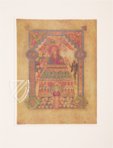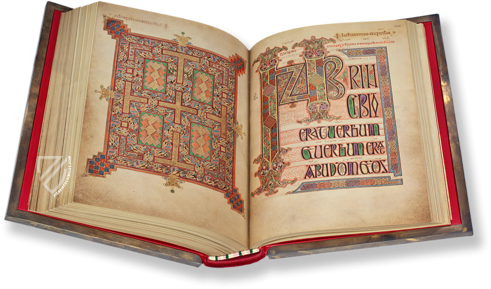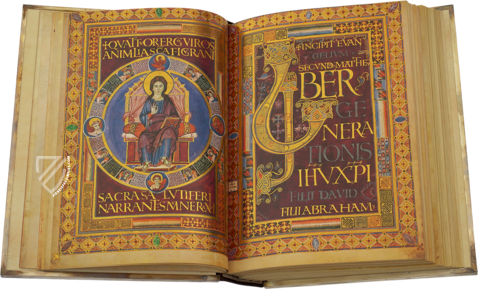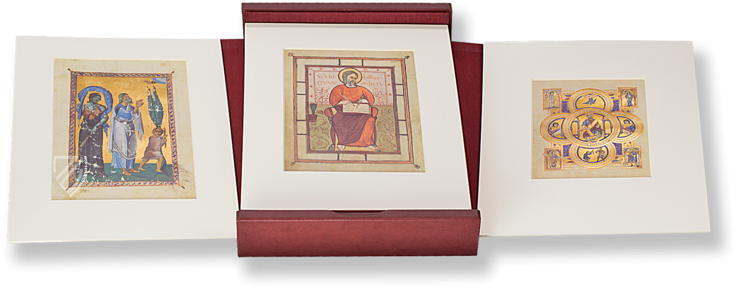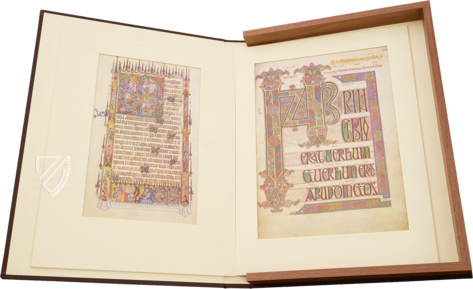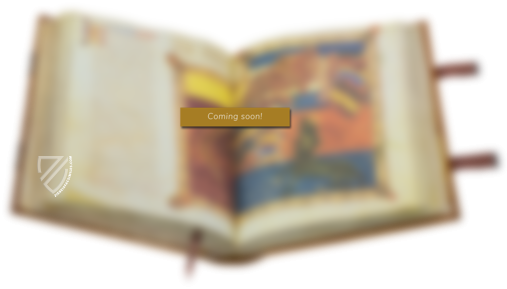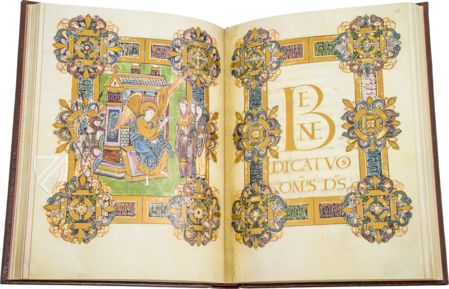Book of Kells
(7,000€ - 10,000€)
Around 800, one of the earliest and simultaneously most splendid manuscripts in the history of book art was created on the Scottish island of Ioana: the so-called Book of Kells. It is named after its long-time abode in the Abbey of Kells in Ireland, with which it is connected by a troubled history. The Gospel Book combines delicate calligraphy with fascinating, almost magical miniatures and initials which bear breathtaking witness to the origins of book illumination in Europe and the Christianisation of the British Isles. The unmistakable ornamentation, characterised by its artistic complexity, zoomorphic elements and artistic interlace ornament in the most precious colours, also runs through the entire work. Almost every page of the over 1200-year-old manuscript is marvellously and fantastically illuminated. It is undoubtedly one of the most famous and valuable books in the world and has been on the UNESCO World Heritage List since 2011.
Book of Kells
In the 6th century, illumination in the center of the foundering Western Roman Empire lived on at a modest standard and merged into Merovingian art. At the same time, an unmistakable, independent style of illustration developed at the periphery of Europe – far removed from the turmoil of the Migration Period and outside of earlier Roman civilization. This painting style is described as insular illumination and developed in Ireland and in surrounding missionary regions since Christianization in the 6th century. The field of research has unanimously identified the 8th century Book of Kells as a textbook example of insular illumination. The mystical masterpiece, wrapped in legends, is one of the oldest books in the world and was selected to the UNESCO World Heritage List in 2011. It contains the four Gospels, a compiled canon written by Eusebius of Caesarea concerning the concordance directories and possessory documents of the Abbey of Kells. The splendid illumination of the book represents an incomparable highpoint of Irish artistic work. Practically every page of the text is furnished with elaborately colored and symbolic illustrations.
A Masterwork Steeped in Legend
Disagreement continues to rule over the origins of the Book of Kells to this day. It is thought that it was made by brilliant monks in the Sottish monastery of St. Colmcille on the island of Iona. The monastery continuously fell victim to Viking raids. In order to protect the precious book, the Scottish monks fled to Kells in Ireland with their masterpiece ca. 806. In the year 1006, the manuscript was stolen from Kells Abbey in the Irish earldom of Meath, as is related by an account of a church robbery from the year 1007. A few months later it reappeared, but without its legendary golden binding. The Book of Kells remained in the Irish parish for a total of 850 years and gained its name from this sojourn. It was later relocated to Trinity College in Dublin for safekeeping and can there be wondered at ever since. However only two pages from the grandiose work can be admired. It lies open in a glass cabinet and astounds around a half-million visitors every year.
Splendid and Original Illumination
The Book of Kells was made by monks unbeknownst by name who possessed the most-sound technical expertise and an excellent knowledge of past and contemporary art. They created early-medieval miniatures which count among the most beautiful images of handcrafted book art altogether. Impressive, full-page illustrations of Christ, Mary with Child, and the Evangelists decorate the work. The typeface is elaborately designed and decorated, the initials in particular were sometimes executed with very fine patterns in luminous colors. The high technical knowledge base of the books’ master is made apparent by the selection and production of the colors and decorative elements. In the place of gold, orpiment was used, a rare arsenic sulfide mineral. Lapis lazuli was applied for the production of the blue color, which in this time could have been found exclusively in Afghanistan. The particular charm of the mystic manuscript is represented by a few humorous depictions. In one part, the letter “N” is made from two small men who reciprocally pull on their beards. At another part, there is a mouse with a stolen communion wafer, and as a punishment, is pursued right across the page by a cat. The Book of Kells is a tour de force of early book art in every respect and measurably influenced medieval manuscript production.
Codicology
- Size / Format
- 680 pages / 33.0 × 25.0 cm
- Origin
- United Kingdom
- Date
- Ca. 800
- Epochs
- Style
- Genre
- Language
- Script
- Insular uncial
- Illustrations
- 10 full-page miniatures, including 4 Evangelist portraits, 13 incipit pages, 10 canon tables, 5 full-page initial pages and hundreds of smaller decorated initials: with two exceptions, all pages are adorned with book decoration
- Content
- Four Gospels
- Artist / School
- Irish monks
- Previous Owners
- Kells Abbey
Trinity College
Book of Kells
Entablature of a Canon Table
Resting on four columns with the Canon Tables created by Eusebius of Caesarea, this elaborate entablature is exemplary of Insular illumination. Blond-haired and a black-bearded, Christ looks directly at the beholder with piercing eyes as he holds in his hands the tongues of two dragons, whose heads emerge from the intricate interlace frame. The Evangelist Symbols for Matthew, Mark, and John can be seen below him and stand upon three medallions with colorful swirls and a checkboard pattern.
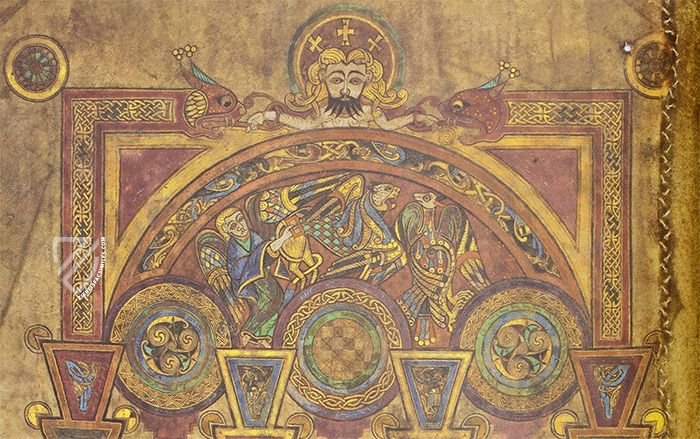
Book of Kells
Chi Rho Monogram
Insular Illumination is distinguished by its decorative initials. This Chi Rho monogram, used to abbreviate the word Christ, marks the beginning of the Life of Christ at Matthew 1:18, and is as grand as any initial prefacing one of the Gospel texts. Known as the labarum, this important Christian symbol was first used as a battle standard by Emperor Constantine.
The codex’s most important page is distinguished by the density of its seemingly infinite patterns. Evocative of contemporary jewelry, it is filled with Celtic interlace, spirals, and knots. Figures imbedded in the composition range from angels to mice eating communion wafers. Yellow and red ochre, indigo, green copper, and even lapis lazuli make up the wonderful color palette.
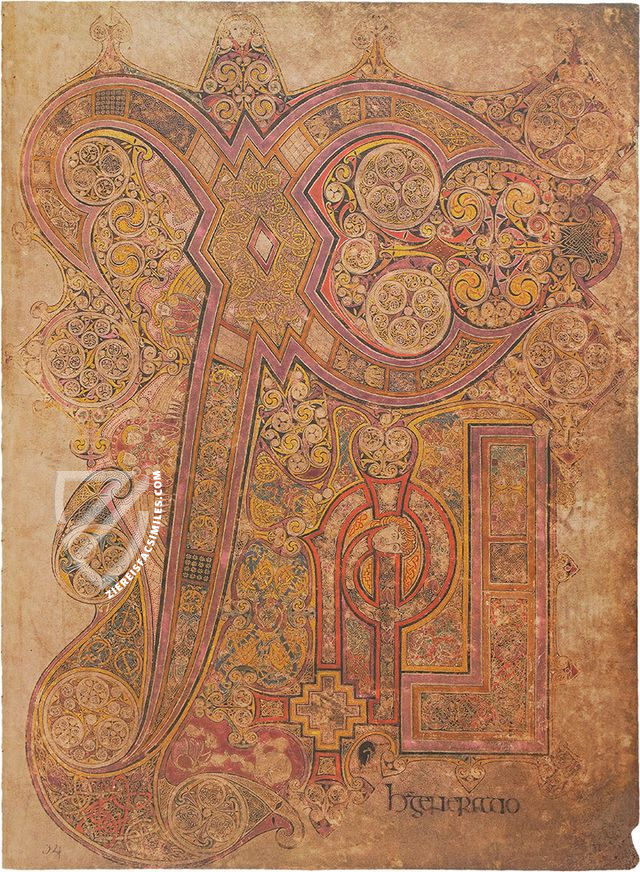
#1 Book of Kells
Languages: German, English
The commentary volume is introduced by a preface by Umberto Eco. Editor: Professor Anton von Euw.
(7,000€ - 10,000€)
#2 Kassette Book of Kells
Languages: German, English
(under 1,000€)
- Treatises / Secular Books
- Apocalypses / Beatus
- Astronomy / Astrology
- Bestiaries
- Bibles / Gospels
- Chronicles / History / Law
- Geography / Maps
- Saints' Lives
- Islam / Oriental
- Judaism / Hebrew
- Single Leaf Collections
- Leonardo da Vinci
- Literature / Poetry
- Liturgical Manuscripts
- Medicine / Botany / Alchemy
- Music
- Mythology / Prophecies
- Psalters
- Other Religious Books
- Games / Hunting
- Private Devotion Books
- Other Genres
- Afghanistan
- Armenia
- Austria
- Belgium
- Belize
- Bosnia and Herzegovina
- China
- Colombia
- Costa Rica
- Croatia
- Cyprus
- Czech Republic
- Denmark
- Egypt
- El Salvador
- Ethiopia
- France
- Germany
- Greece
- Guatemala
- Honduras
- Hungary
- India
- Iran
- Iraq
- Israel
- Italy
- Japan
- Jordan
- Kazakhstan
- Kyrgyzstan
- Lebanon
- Liechtenstein
- Luxembourg
- Mexico
- Morocco
- Netherlands
- Palestine
- Panama
- Peru
- Poland
- Portugal
- Romania
- Russia
- Serbia
- Spain
- Sri Lanka
- Sweden
- Switzerland
- Syria
- Tajikistan
- Turkey
- Turkmenistan
- Ukraine
- United Kingdom
- United States
- Uzbekistan
- Vatican City
- A. Oosthoek, van Holkema & Warendorf
- Aboca Museum
- Ajuntament de Valencia
- Akademie Verlag
- Akademische Druck- u. Verlagsanstalt (ADEVA)
- Aldo Ausilio Editore - Bottega d’Erasmo
- Alecto Historical Editions
- Alkuin Verlag
- Almqvist & Wiksell
- Amilcare Pizzi
- Andreas & Andreas Verlagsbuchhandlung
- Archa 90
- Archiv Verlag
- Archivi Edizioni
- Arnold Verlag
- ARS
- Ars Magna
- ArtCodex
- AyN Ediciones
- Azimuth Editions
- Badenia Verlag
- Bärenreiter-Verlag
- Belser Verlag
- Belser Verlag / WK Wertkontor
- Benziger Verlag
- Bernardinum Wydawnictwo
- BiblioGemma
- Biblioteca Apostolica Vaticana (Vaticanstadt, Vaticanstadt)
- Bibliotheca Palatina Faksimile Verlag
- Bibliotheca Rara
- Boydell & Brewer
- Bramante Edizioni
- Bredius Genootschap
- Brepols Publishers
- British Library
- C. Weckesser
- Caixa Catalunya
- Canesi
- CAPSA, Ars Scriptoria
- Caratzas Brothers, Publishers
- Carus Verlag
- Casamassima Libri
- Centrum Cartographie Verlag GmbH
- Chavane Verlag
- Christian Brandstätter Verlag
- Circulo Cientifico
- Club Bibliófilo Versol
- Club du Livre
- CM Editores
- Collegium Graphicum
- Collezione Apocrifa Da Vinci
- Comissão Nacional para as Comemorações dos Descobrimentos Portugueses
- Coron Verlag
- Corvina
- CTHS
- D. S. Brewer
- Damon
- De Agostini/UTET
- De Nederlandsche Boekhandel
- De Schutter
- Deuschle & Stemmle
- Deutscher Verlag für Kunstwissenschaft
- DIAMM
- Droz
- E. Schreiber Graphische Kunstanstalten
- Ediciones Boreal
- Ediciones Grial
- Ediclube
- Edições Inapa
- Edilan
- Editalia
- Edition Deuschle
- Edition Georg Popp
- Edition Leipzig
- Edition Libri Illustri
- Editiones Reales Sitios S. L.
- Éditions de l'Oiseau Lyre
- Editions Medicina Rara
- Editorial Casariego
- Editorial Mintzoa
- Editrice Antenore
- Editrice Velar
- Edizioni Edison
- Egeria, S.L.
- Eikon Editores
- Electa
- Emery Walker Limited
- Enciclopèdia Catalana
- Eos-Verlag
- Ephesus Publishing
- Ernst Battenberg
- Eugrammia Press
- Extraordinary Editions
- Fackelverlag
- Facsimila Art & Edition
- Facsimile Editions Ltd.
- Facsimilia Art & Edition Ebert KG
- Faksimile Verlag
- Feuermann Verlag
- Folger Shakespeare Library
- Franco Cosimo Panini Editore
- Friedrich Wittig Verlag
- Fundación Hullera Vasco-Leonesa
- G. Braziller
- Gabriele Mazzotta Editore
- Gebr. Mann Verlag
- Gesellschaft für graphische Industrie
- Getty Research Institute
- Giovanni Domenico de Rossi
- Giunti Editore
- Graffiti
- Grafica European Center of Fine Arts
- Guido Pressler
- Guillermo Blazquez
- Gustav Kiepenheuer
- H. N. Abrams
- Harrassowitz
- Harvard University Press
- Helikon
- Hendrickson Publishers
- Henning Oppermann
- Herder Verlag
- Hes & De Graaf Publishers
- Hoepli
- Holbein-Verlag
- Houghton Library
- Hugo Schmidt Verlag
- Idion Verlag
- Il Bulino, edizioni d'arte
- ILte
- Imago
- Insel Verlag
- Insel-Verlag Anton Kippenberger
- Instituto de Estudios Altoaragoneses
- Instituto Nacional de Antropología e Historia
- Introligatornia Budnik Jerzy
- Istituto dell'Enciclopedia Italiana - Treccani
- Istituto Ellenico di Studi Bizantini e Postbizantini
- Istituto Geografico De Agostini
- Istituto Poligrafico e Zecca dello Stato
- Italarte Art Establishments
- Jan Thorbecke Verlag
- Johnson Reprint Corporation
- Josef Stocker
- Josef Stocker-Schmid
- Jugoslavija
- Karl W. Hiersemann
- Kasper Straube
- Kaydeda Ediciones
- Kindler Verlag / Coron Verlag
- Kodansha International Ltd.
- Konrad Kölbl Verlag
- Kurt Wolff Verlag
- La Liberia dello Stato
- La Linea Editrice
- La Meta Editore
- Lambert Schneider
- Landeskreditbank Baden-Württemberg
- Leo S. Olschki
- Les Incunables
- Liber Artis
- Library of Congress
- Libreria Musicale Italiana
- Lichtdruck
- Lito Immagine Editore
- Lumen Artis
- Lund Humphries
- M. Moleiro Editor
- Maison des Sciences de l'homme et de la société de Poitiers
- Manuscriptum
- Martinus Nijhoff
- Maruzen-Yushodo Co. Ltd.
- MASA
- Massada Publishers
- McGraw-Hill
- Metropolitan Museum of Art
- Militos
- Millennium Liber
- Müller & Schindler
- Nahar - Stavit
- Nahar and Steimatzky
- National Library of Wales
- Neri Pozza
- Nova Charta
- Oceanum Verlag
- Odeon
- Orbis Mediaevalis
- Orbis Pictus
- Österreichische Staatsdruckerei
- Oxford University Press
- Pageant Books
- Parzellers Buchverlag
- Patrimonio Ediciones
- Pattloch Verlag
- PIAF
- Pieper Verlag
- Plon-Nourrit et cie
- Poligrafiche Bolis
- Presses Universitaires de Strasbourg
- Prestel Verlag
- Princeton University Press
- Prisma Verlag
- Priuli & Verlucca, editori
- Pro Sport Verlag
- Propyläen Verlag
- Pytheas Books
- Quaternio Verlag Luzern
- Reales Sitios
- Recht-Verlag
- Reichert Verlag
- Reichsdruckerei
- Reprint Verlag
- Riehn & Reusch
- Roberto Vattori Editore
- Rosenkilde and Bagger
- Roxburghe Club
- Salerno Editrice
- Saltellus Press
- Sandoz
- Sarajevo Svjetlost
- Schöck ArtPrint Kft.
- Schulsinger Brothers
- Scolar Press
- Scrinium
- Scripta Maneant
- Scriptorium
- Shazar
- Siloé, arte y bibliofilia
- SISMEL - Edizioni del Galluzzo
- Sociedad Mexicana de Antropología
- Société des Bibliophiles & Iconophiles de Belgique
- Soncin Publishing
- Sorli Ediciones
- Stainer and Bell
- Studer
- Styria Verlag
- Sumptibus Pragopress
- Szegedi Tudomànyegyetem
- Taberna Libraria
- Tarshish Books
- Taschen
- Tempus Libri
- Testimonio Compañía Editorial
- Thames and Hudson
- The Clear Vue Publishing Partnership Limited
- The Facsimile Codex
- The Folio Society
- The Marquess of Normanby
- The Richard III and Yorkist History Trust
- Tip.Le.Co
- TouchArt
- TREC Publishing House
- TRI Publishing Co.
- Trident Editore
- Tuliba Collection
- Typis Regiae Officinae Polygraphicae
- Union Verlag Berlin
- Universidad de Granada
- University of California Press
- University of Chicago Press
- Urs Graf
- Vallecchi
- Van Wijnen
- VCH, Acta Humaniora
- VDI Verlag
- VEB Deutscher Verlag für Musik
- Verlag Anton Pustet / Andreas Verlag
- Verlag Bibliophile Drucke Josef Stocker
- Verlag der Münchner Drucke
- Verlag für Regionalgeschichte
- Verlag Styria
- Vicent Garcia Editores
- W. Turnowski Ltd.
- W. Turnowsky
- Waanders Printers
- Wiener Mechitharisten-Congregation (Wien, Österreich)
- Wissenschaftliche Buchgesellschaft
- Wissenschaftliche Verlagsgesellschaft
- Wydawnictwo Dolnoslaskie
- Xuntanza Editorial
- Zakład Narodowy
- Zollikofer AG

